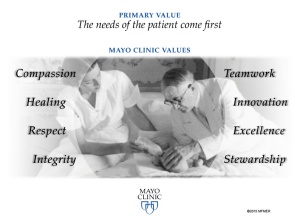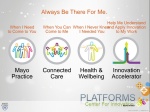 Our final visit on the trip was to the Mayo Innovation Center in Rochester, MN. I had been aware of the Mayo Clinic Innovation work since starting the work with User-centred Healthcare Design in 2008 (ish) and so it was a bit of a seminal moment for me to find myself looking up at the hallowed clinic.
Our final visit on the trip was to the Mayo Innovation Center in Rochester, MN. I had been aware of the Mayo Clinic Innovation work since starting the work with User-centred Healthcare Design in 2008 (ish) and so it was a bit of a seminal moment for me to find myself looking up at the hallowed clinic. We were walked through the atrium and up to the Innovation Centre by Linda Cooper. It brings home just how integrated the unit centre is that through the double doors at one end you are in rheumatology… We were greeted by fresh coffee and donuts and more importantly by Douglas Wood, M.D. Doug talked us through the history of the centre and described the route from idea to the 63 staff across two sites that the centre comprises of now. For me, some of the most powerful aspects of the journey were how the work of the centre talks directly to the stated strategic goals of the organisation.
We were walked through the atrium and up to the Innovation Centre by Linda Cooper. It brings home just how integrated the unit centre is that through the double doors at one end you are in rheumatology… We were greeted by fresh coffee and donuts and more importantly by Douglas Wood, M.D. Doug talked us through the history of the centre and described the route from idea to the 63 staff across two sites that the centre comprises of now. For me, some of the most powerful aspects of the journey were how the work of the centre talks directly to the stated strategic goals of the organisation.  Some six years ago the Mayo clinic added ‘innovation’ to it’s core values. This gave a clear role and purpose for the innovation centre to respond to and a sense of legitimacy to work differently. The centre is a core resource for any and all of the 36,000 members of staff on site (in Rochester). The team who created the centre were based in the department of medicine and, at the time, were looking around for interesting ways to improve the way they delivered care. They identified the global design firm IDEO in 2002, and worked with them to understand the role human centred design might play in healthcare innovation. That relationship with designers has remained core to the centre’s activity with 14 designers being on the payroll currently. The IDEO collaboration led to the SPARC Innovation Programme and the first physical space was established where staff could prototype and design healthcare in the same environment in which healthcare was delivered. By 2006 they had undertaken enough projects to demonstrate a sufficient return on investment to their colleagues and the board. Doug cited being able to demonstrate the effect to key opinion leaders (surgeons: hard to impress but once on side, powerful advocates). The form of evidence was varied, from
Some six years ago the Mayo clinic added ‘innovation’ to it’s core values. This gave a clear role and purpose for the innovation centre to respond to and a sense of legitimacy to work differently. The centre is a core resource for any and all of the 36,000 members of staff on site (in Rochester). The team who created the centre were based in the department of medicine and, at the time, were looking around for interesting ways to improve the way they delivered care. They identified the global design firm IDEO in 2002, and worked with them to understand the role human centred design might play in healthcare innovation. That relationship with designers has remained core to the centre’s activity with 14 designers being on the payroll currently. The IDEO collaboration led to the SPARC Innovation Programme and the first physical space was established where staff could prototype and design healthcare in the same environment in which healthcare was delivered. By 2006 they had undertaken enough projects to demonstrate a sufficient return on investment to their colleagues and the board. Doug cited being able to demonstrate the effect to key opinion leaders (surgeons: hard to impress but once on side, powerful advocates). The form of evidence was varied, from  costs savings through to patient and staff experience, and also ‘the Buzz’ generated from working differently and using design. The centre’s approach is very recognisably design led. Think Big, Start Small and Move Fast, and the design methods are human centred with a clear focus on prototyping and making. They deliver their activity across 4 platforms develop and refined over the last few years to
costs savings through to patient and staff experience, and also ‘the Buzz’ generated from working differently and using design. The centre’s approach is very recognisably design led. Think Big, Start Small and Move Fast, and the design methods are human centred with a clear focus on prototyping and making. They deliver their activity across 4 platforms develop and refined over the last few years to  allow strategic focus, with the voice of the patient at the centre. There is a model of open collaboration with local and strategic collaborations. There is specifically an annual CODE award ($50k) to support innovative awards, winners not only get cash but access to the Innovation centre staff. Multi disciplinarity is at the core of the practice of how the Centre delivers innovation. Each team has a project-manager, a designer, an IT innovation persona and the clinical lead. For me it is the inclusion of the IT innovator that is so telling in the range of projects that the centre can address. IT is an enabler rather than a limiting factor for the centre. An experience so far removed from my experience to be truly revolutionary! Strategically having the living lab environment, companies approach Mayo to try out new tech and products near to patients (e.g. Delos living). Mayo also partners other initiatives like the rock health consortium, a group specifically looking to use technological innovation in health through supporting start-ups. The centre also can act as a placement for students of different disciplines, design, IT, economics. This happens at different levels, secondment to project or specific Doctoral programmes supported by academic partners. Alongside this learning environment CFI staff can undertake and complete a recognised curriculum and gain a certificate in innovation. Doug described a current ‘spin off’ project with Arizona state University (the biggest in the States) looking at improving retention and QoL of the students. They are using the model developed to improve the wellbeing of Mayo’s employees, and using their user/human centred approaches, coming up with tools to support the student wellbeing services to identify students at risk of stress and helping with life planning.
allow strategic focus, with the voice of the patient at the centre. There is a model of open collaboration with local and strategic collaborations. There is specifically an annual CODE award ($50k) to support innovative awards, winners not only get cash but access to the Innovation centre staff. Multi disciplinarity is at the core of the practice of how the Centre delivers innovation. Each team has a project-manager, a designer, an IT innovation persona and the clinical lead. For me it is the inclusion of the IT innovator that is so telling in the range of projects that the centre can address. IT is an enabler rather than a limiting factor for the centre. An experience so far removed from my experience to be truly revolutionary! Strategically having the living lab environment, companies approach Mayo to try out new tech and products near to patients (e.g. Delos living). Mayo also partners other initiatives like the rock health consortium, a group specifically looking to use technological innovation in health through supporting start-ups. The centre also can act as a placement for students of different disciplines, design, IT, economics. This happens at different levels, secondment to project or specific Doctoral programmes supported by academic partners. Alongside this learning environment CFI staff can undertake and complete a recognised curriculum and gain a certificate in innovation. Doug described a current ‘spin off’ project with Arizona state University (the biggest in the States) looking at improving retention and QoL of the students. They are using the model developed to improve the wellbeing of Mayo’s employees, and using their user/human centred approaches, coming up with tools to support the student wellbeing services to identify students at risk of stress and helping with life planning.

Reblogged this on Nord's Blog.
LikeLiked by 1 person